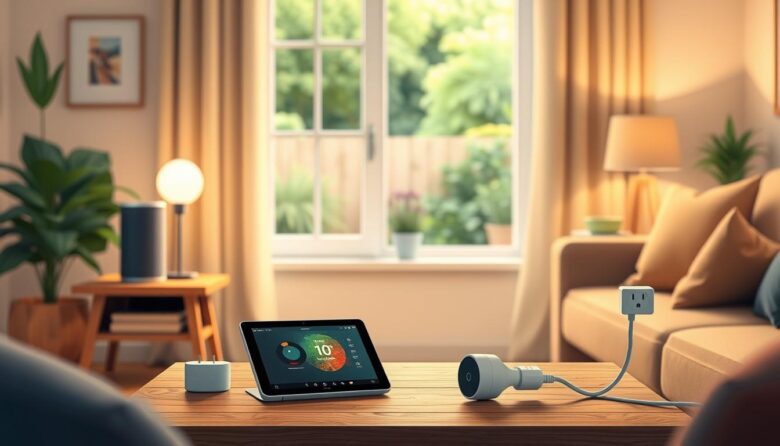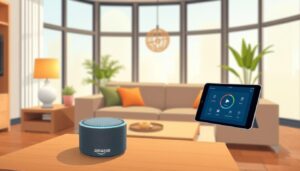Imagine your living space working for you. Lights adjust on their own. Your thermostat learns your schedule. This is the power of modern technology.
You do not need to be a tech expert to start. Many user-friendly gadgets make it simple. They connect through Wi-Fi or Bluetooth with ease.
These systems offer immediate improvements to comfort and convenience. You can also save money on energy bills. Security gets a major boost, too.
This guide provides clear, step-by-step instructions. We focus on practical tasks for newcomers. You can build a smarter life, one room at a time.
Introduction to Home Automation Projects
Modern residences gain new capabilities through networked technology. This concept revolves around intelligent gadgets that connect to the internet. They can be controlled from anywhere using a phone app or voice command.
Understanding the Basics of Home Automation
A smart home system relies on a network of devices. These items talk to each other using Wi-Fi, Bluetooth, or Zigbee. This creates a centralized control point for your entire residence.
Sensors are the eyes and ears of the setup. They monitor changes in motion, temperature, and light levels. This information allows the system to react automatically to its surroundings.
Actuators are the parts that perform physical actions. Examples include smart light switches and motorized valves. They carry out the commands sent by the user or the system.
Why Start with DIY Projects?
Beginning with do-it-yourself tasks offers an affordable entry point. You learn the fundamental concepts hands-on. This approach provides immediate practical benefits without a large upfront cost.
DIY methods build your confidence and technical knowledge gradually. You gain a deep understanding of how components work together. This flexibility lets you tailor solutions to your specific needs and preferences.
The Fundamentals of Smart Home Systems
At the core of modern residential technology are networks of communicating devices that work in harmony. These interconnected components form the backbone of any intelligent living environment.
How Connectivity and Sensors Enhance Living
Modern sensors detect various environmental factors like motion, temperature, and light levels. This data enables sophisticated automation scenarios tailored to specific needs.
Connectivity protocols allow different manufacturers’ products to communicate effectively. This creates unified systems where lighting, climate control, and security work together seamlessly.
Benefits of Automating Your Home Devices
Automating household devices delivers unparalleled convenience through remote control capabilities. You can manage lights, thermostats, and security from anywhere using mobile applications.
Energy efficiency represents a major advantage of this technology. Smart systems optimize consumption patterns and help reduce utility costs significantly.
Enhanced security emerges from automated setups with motion detectors and surveillance cameras. These provide real-time notifications about unusual activity.
Exploring Easy and Budget-Friendly DIY Projects
Practical enhancements to your living environment don’t require complex installations or significant investments. Many straightforward upgrades deliver immediate convenience and security benefits.
Smart Lighting Solutions for Beginners
Intelligent illumination represents the perfect starting point for technological improvements. Smart bulbs and switches connect easily to your network through simple apps.
These solutions allow control of brightness, color, and timing from your smartphone. You can create customized scenes for different activities and times of day.
Motion detection technology adds hands-free convenience to any space. Install sensors in hallways, staircases, and bathrooms for automatic activation.
Simple Security System Enhancements
Basic security upgrades provide peace of mind through affordable technology. Motion-activated exterior lights deter intruders while improving nighttime visibility.
Smart locks offer remote access control and activity notifications. You can grant temporary entry to guests while monitoring all door activity.
Window and door sensors detect unauthorized entry attempts. Budget-friendly cameras provide real-time alerts when movement is detected around your property.
These straightforward installations create comprehensive protection systems without professional installation costs. They work together to enhance safety through coordinated responses.
Integrating Smart Home Devices Seamlessly
The true power of smart technology emerges when different devices work together seamlessly. Creating a unified ecosystem requires careful planning from the start.
Compatibility issues can frustrate users who expect smooth operation. Researching device specifications before purchase prevents costly mistakes.
Linking Devices with Mobile Apps and Voice Assistants
Mobile applications serve as central control hubs for your smart systems. They consolidate management of lights, thermostats, and security into single interfaces.
Voice assistants like Alexa and Google Assistant provide intuitive control methods. Natural language commands make technology accessible to everyone.
Platforms like IFTTT bridge compatibility gaps between different manufacturers. They enable coordinated automation scenarios across various devices.
Successful integration creates routines where multiple systems respond to single triggers. This delivers unmatched convenience and efficiency for daily living.
Prioritize devices that share common communication protocols. This ensures your setup can expand as your needs evolve over time.
Leveraging Voice Commands and Digital Assistants
Natural language interaction eliminates barriers between users and their devices. Speaking aloud to control your environment feels intuitive and futuristic.
Voice control provides hands-free convenience when your hands are busy. You can manage multiple devices without touching a single switch.
Digital assistants understand natural speech patterns. This makes technology accessible to people of all technical skill levels.
Setting Up Custom Routines with Google Assistant
Google Assistant leads the market in voice-controlled systems. It works seamlessly across Android phones and smart speakers.
Creating custom routines combines multiple actions into single voice commands. Say “Good morning” to trigger lights, thermostat adjustments, and news updates simultaneously.
The setup process guides you through selecting triggers and actions. You can build sophisticated automation without any programming knowledge.
Personalized scenes create cohesive experiences for different activities. A “movie time” command can dim lights and start your entertainment system.
Voice commands extend to household appliances like coffee makers and vacuums. This brings automation to previously manual daily tasks.
Innovative Projects Using NFC and Wi-Fi Modules
Simple taps can now trigger complex routines with programmable NFC tags that bridge the gap between digital commands and physical interaction. These small chips create tangible control points throughout your living space.
Programming NFC Tags for Automation
Getting started requires minimal technical knowledge. First, download a free app like NFC Tools for Android or NFC TagWriter for iOS. These applications guide you through the programming process step by step.
Identify tasks you want to automate, such as lighting control or music playback. Position tags strategically near entryways or bedside tables for easy access. The flexibility to reprogram tags makes them adaptable as your needs evolve.
Wi-Fi modules expand your control capabilities beyond physical proximity. They enable remote management of systems from anywhere with internet access. Environmental monitoring projects can track conditions while adjusting equipment automatically.
Combining NFC for local triggers with Wi-Fi for remote access creates comprehensive control systems. This approach offers both immediate physical interaction and global management possibilities.
Tailoring Your Automation Routine for Everyday Life
True personalization occurs when your smart system adapts to your unique daily patterns. Generic settings transform into responsive assistants that anticipate your needs.
Crafting Personalized Scenes and Schedules
Create “Good Morning” routines that coordinate multiple actions simultaneously. Your system can brew coffee, adjust blinds, and set perfect temperature levels.
Evening routines provide security and comfort through single commands. They lock doors, turn off lights, and activate security systems automatically.
Temperature schedules optimize both comfort and energy use throughout the day. Program your thermostat to lower settings during work hours and raise them before you return.
Your smart setup becomes a personal assistant with these capabilities:
- Calendar synchronization for appointment reminders
- Chore management systems with family task assignments
- Laundry completion notifications and cooking guidance
- Activity-specific scenes for work, relaxation, or entertainment
Effective customization requires identifying repetitive tasks technology can handle. This allows you to focus on activities requiring human judgment while your system manages routine operations.
Home Automation Projects for Beginners
Starting your journey into connected living spaces can feel overwhelming, but numerous beginner-friendly options exist. These initial efforts build confidence while delivering tangible benefits.
Many cost-effective solutions use readily available components. You can create sophisticated systems without significant financial investment.
Budget-Friendly Ideas and Simple Tutorials
Arduino and Raspberry Pi platforms offer excellent starting points for DIY enthusiasts. These affordable boards power various creative endeavors.
Voice recognition systems can respond to commands in multiple languages. This makes technology accessible to diverse household members.
Sound-activated controls provide unique interaction methods. Simple claps or snaps can manage computer applications effortlessly.
GSM-based systems enable remote control from anywhere globally. This prevents energy waste from forgotten appliances.
Automatic lighting adjusts brightness based on environmental conditions. This optimizes comfort while conserving electricity.
Smart Home Integration Without the Hassle
Touch panel projects create affordable alternatives to commercial control systems. Arduino-based interfaces work through physical touch or wireless apps.
Node-RED tutorials guide beginners through multi-device control setups. Local Wi-Fi networks enable seamless management of connected gadgets.
Bluetooth connectivity allows simple Android app integration. This approach minimizes technical complexity while delivering reliable performance.
Well-documented platforms ensure troubleshooting resources remain readily available. Online communities provide support throughout your learning process.
Advanced Techniques for Enhanced Home Security
Taking your security to the next level requires integrating multiple protective layers. These advanced approaches create comprehensive systems that work together seamlessly.
Visible deterrents like cameras and alarm signage discourage potential intruders before they attempt entry. This first line of defense provides peace of mind through proactive protection.
Implementing Motion Sensors and Smart Locks
Motion-activated lighting serves dual purposes for exterior security. It deters intruders while providing safe navigation at night.
Smart lock technology represents a significant upgrade over traditional locks. You gain remote control via smartphone apps and detailed activity logs.
These locks allow temporary access credentials for guests without physical key distribution. This eliminates security risks from lost or copied keys.
Security cameras with mobile integration transform passive recording into active monitoring. They send real-time alerts when detecting movement around your property.
Window and door sensors create comprehensive perimeter protection. They detect unauthorized entry attempts immediately upon occurrence.
Smart alarm systems coordinate multiple security devices into unified responses. They activate automatically when specific events like unexpected door openings occur.
Geofencing technology adds intelligent automation using smartphone location data. Your system arms when you leave and disarms upon your return.
DIY enthusiasts can build professional-grade protection using Arduino components. These affordable systems detect intruder movement and send text alerts automatically.
Final Insights for Your Smart Home Journey
Your journey into intelligent living spaces represents a continuous path of discovery and improvement. Each project builds your confidence and technical understanding.
These systems deliver tangible benefits for comfort and energy management. They adapt to your unique lifestyle patterns seamlessly.
Security remains crucial throughout your experience. Choose reputable brands and maintain strong passwords for protection.
Research compatibility before adding new devices to your ecosystem. This prevents frustration and ensures harmonious integration.
The expanding world of smart home technology offers endless possibilities. Start with simple projects from our comprehensive list.
Gradually advance to more sophisticated automation as your skills grow. This approach creates a personalized system operating at a professional level.



